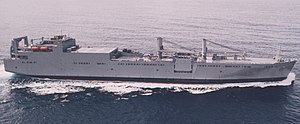
USNS Bob Hope (T-AKR-300), the lead ship of its class of vehicle cargo ships for Army vehicle prepositioning, was a naval ship of the United States named after Bob Hope, the entertainer. Very few ships of the United States Navy have been named after a person who was alive at the time of the christening.

Military Sealift Command (MSC) is an organization that controls the replenishment and military transport ships of the United States Navy. Military Sealift Command has the responsibility for providing sealift and ocean transportation for all US military services as well as for other government agencies. It first came into existence on 9 July 1949 when the Military Sea Transportation Service (MSTS) became solely responsible for the Department of Defense's ocean transport needs. The MSTS was renamed the Military Sealift Command in 1970.
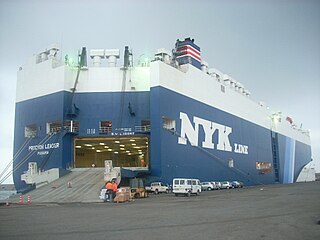
Roll-on/roll-off ships are cargo ships designed to carry wheeled cargo, such as cars, motorcycles, trucks, semi-trailer trucks, buses, trailers, and railroad cars, that are driven on and off the ship on their own wheels or using a platform vehicle, such as a self-propelled modular transporter. This is in contrast to lift-on/lift-off (LoLo) vessels, which use a crane to load and unload cargo.

Technical research ships were used by the United States Navy during the 1960s to gather intelligence by monitoring, recording and analyzing wireless electronic communications of nations in various parts of the world. At the time these ships were active, the mission of the ships was covert and discussion of the true mission was prohibited. The mission of the ships was publicly given as conducting research into atmospheric and communications phenomena. However, the true mission was more or less an open secret and the ships were commonly referred to as "spy ships".
A joint support ship (JSS) is a multi-role naval vessel capable of launching and supporting joint amphibious and airlift operations. It can also provide command and control, sealift and seabasing, underway replenishment, disaster relief and logistics capabilities for combined land and sea operations.
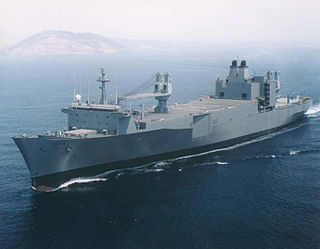
The Algol-class vehicle cargo ships, also known as Fast Sealift Ships (FSS) or SL-7s, are currently the fastest cargo ships in the world, capable of speeds in excess of 33 knots (61 km/h). Originally built in 1972 and 1973 as high-speed container ships known as SL-7's for Sea-Land Services, Inc., the ships' high operating costs limited their profitability. All eight ships were acquired by the US Navy in 1981 and 1982, with the last ship converted, delivered to and placed in service with Military Sealift Command in 1986. The conversion entailed the installation of four cranes, addition of roll on/roll off capability and a redesign of the cargo hold to better facilitate storage of vehicles. Due largely to their high cost of operation, all fast sealift ships are kept in Reduced Operating Status, but can be activated and ready to sail in 96 hours. All ships are named after bright stars in the night sky.
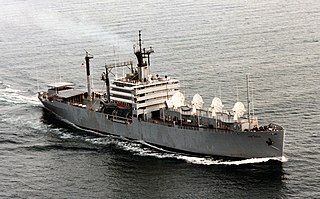
A tracking ship, also called a missile range instrumentation ship or range ship, is a ship equipped with antennas and electronics to support the launching and tracking of missiles and rockets. Since many missile ranges launch over ocean areas for safety reasons, range ships are used to extend the range of shore-based tracking facilities.

USNS Comet (T-AK-269), later T-LSV-7, later T-AKR-7, later SS Comet, is a vehicle landing ship built for the United States Navy. The lone ship of her class, she is named for the comet, and is the fourth U.S. Naval vessel to bear the name.

HST-2, formerly named USNS Puerto Rico and Alakai, is a vessel owned by the United States Navy Military Sealift Command. She was originally Hawaii Superferry's first high-speed ferry. The vessel was later chartered by Bay Ferries Limited to operate a ferry service between Maine and Yarmouth, Nova Scotia.

USNS GySgt Fred W. Stockham (T-AK-3017) is a Shughart-class container & roll-on roll-off support vessel in the United States Navy's Military Sealift Command (MSC). The vessel is the second Navy ship named after Marine Gunnery Sergeant Fred W. Stockham (1881–1918), who was posthumously awarded the Medal of Honor during World War I.
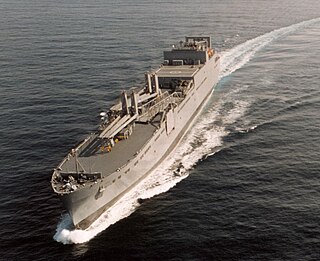
USNS Watkins (T-AKR-315) is one of Military Sealift Command's nineteen Large, Medium-Speed Roll-on/Roll-off Ships and is part of the 33 ships in the Prepositioning Program. She is a Watson-class vehicle cargo ship.
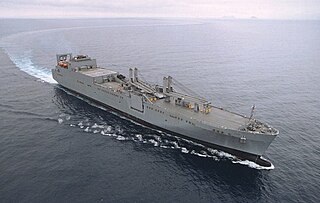
USNS Pomeroy (T-AKR-316) is one of Military Sealift Command's nineteen Large, Medium-Speed Roll-on/Roll-off Ships and is part of the 33 ships in the Prepositioning Program. She is a Watson-class vehicle cargo ship named for Private First Class Ralph E. Pomeroy, a Medal of Honor recipient.

The Watson-class vehicle cargo ship is a series of vehicle cargo ships, used by the United States for prepositioning of ground vehicles. The class comprises eight of Military Sealift Command's nineteen Large, Medium-Speed Roll-on/Roll-off ships and is one part of the 33 ships involved in the Prepositioning Program.

USNS Guam (T-HST-1), formerly Hawaii Superferry's Huakai, is a United States Navy high-speed transport vessel. The ship was completed in September 2008 and was intended to start Hawaiian service in May 2009, though delivery postponements saw that planned service canceled. In the Hawaiian language, huakaʻi means "journey".

USNS Mendonca (T-AKR-303) was a Bob Hope-class roll on roll off vehicle cargo ship of the United States Navy. She was built by Northrop Grumman Ship Systems, New Orleans and delivered to the Navy on 30 January 2001. They assigned her to the United States Department of Defense's Military Sealift Command. Mendonca is named for Medal of Honor recipient Sergeant Leroy A. Mendonca, and is one of 11 Surge LMSRs operated by a private company under contract to the Military Sealift Command. She was assigned to the MSC Atlantic surge force and is maintained in Ready Operational Status 4. On 26 September 2022, Mendonca left service and was stricken from the Naval Vessel Register.

USNS Benavidez (T-AKR-306) was a Bob Hope-class roll on roll off vehicle cargo ship of the United States Navy. She was built by Northrop Grumman Ship Systems, New Orleans and delivered to the Navy on 10 September 2003. They assigned her to the United States Department of Defense's Military Sealift Command. Benavidez is named for Medal of Honor recipient Master Sergeant Roy P. Benavidez, and is one of 11 Surge LMSRs operated by a private company under contract to the Military Sealift Command. She was assigned to the MSC Atlantic surge force and is maintained in Ready Operational Status 4. On 21 September 2022, Benavidez left service and was stricken from the Naval Vessel Register.

The Spearhead-class expeditionary fast transport (EPF) is a United States Navy–led shipbuilding program to provide a high-speed, shallow draft vessel intended for rapid intra-theater transport of medium-sized cargo payloads. The EPFs can reach speeds of 35–45 knots (65–83 km/h; 40–52 mph), and allow the rapid transit and deployment of conventional or special forces, equipment and supplies. The vessels are a part of Military Sealift Command's Sealift Program. The class was previously designated as "Joint High Speed Vessel (JHSV)", and redesignated in September 2015.
Large, Medium-Speed Roll-on/Roll-off (LMSR) refers to several classes of Military Sealift Command (MSC) roll-on/roll-off type cargo ships. Some are purpose-built for military cargo, while others were converted.

USNS 2nd Lt. John P. Bobo, formally MV 2nd Lt. John P. Bobo (AK-3008) is a strategic sealift ship currently in service with the United States Navy since its original charter in 1985. The ship is named after US Marine Medal of Honor recipient 2nd Lieutenant John P. Bobo. She is the only US Navy ship to bear the name.
